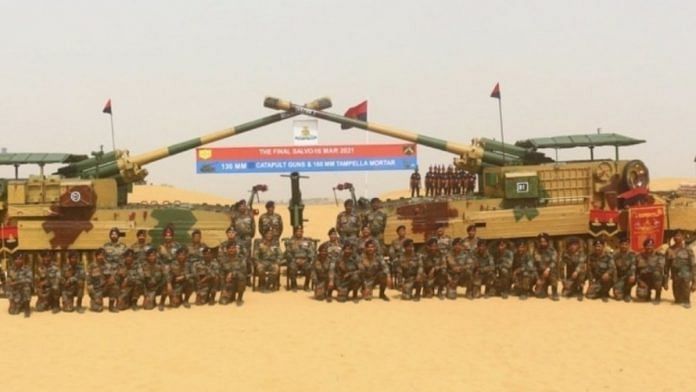New Delhi: Two of the Army’s longest serving artillery systems — the 130mm self-propelled M-46 Catapult guns and the 160mm Tampella mortars — were decommissioned Tuesday at the Mahajan Field Firing Ranges in the deserts of Jaisalmer.
The ceremony was marked with a customary last firing, in the presence of Lt. Gen. K. Ravi Prasad, Director General of Artillery, the Army said in a statement, adding that the systems have been decommissioned to make way for newer equipment employing the latest technologies.
While the Catapult guns had been in the Army’s inventory for nearly 40 years, the Tampella mortars were inducted after the 1962 India-China war.
The 130mm Catapult was a merger of two existing weapon systems — Vijayanta tanks and 130mm M-46 guns. The platform, with a range of more than 27km, filled the need for a mobile artillery gun system to support strike formations on the western borders, after the 1965 and 1971 wars.
The 160mm Tampella mortars, with a range of 9.6km, were inducted for the mountainous northern borders. They were imported from the Israeli Defence Forces. The mortars were deployed on the Line of Control (LoC) in the Leepa valley and the Hajipir Bowl, and played a crucial role in the 1999 Kargil conflict.
Here’s a detailed look at the weapon systems and the roles they played during their decades-long tenures in the force.
Also read: Senior IAF officer dies after MiG-21 fighter jet crashes during training mission
The 130mm Catapult guns
After the 1965 and 1971 wars between India and Pakistan, the Army was in search of mobile artillery gun systems, primarily for the strike formations on the western borders.
The Defence Research and Development Organisation (DRDO) then merged the Vijayanta tanks platform and the 130mm M-46 guns into these indigenous self-propelled gun systems.
According to Army sources, the production of original Catapult guns began in the late 1970s. They were inducted in 1981. More than seven self-propelled units were subsequently equipped with these guns.
Operation Parakram in 2001 is among the landmark operations in which the Catapult guns were deployed. During this operation, they were deployed in the Samba district of Jammu and Kashmir — in the chicken neck area, and Shakargarh bulge.
More recently, in 2019, they were deployed during Op Zafran after the Pulwama terror attack.
Two medium field regiments, which were keeping the guns, fired the final shot Tuesday. The same regiments are now shifting to the new K-9 Vajra gun systems.
Lt Gen. P.R. Shankar (retd), former director general of artillery, said the guns were effective and lethal and even heavier than the Bofors guns. But they are vintage now.
“The decommissioning is delayed by a decade since the entire artillery modernisation plan got delayed. The Catapults were good guns, but beyond a point, no spares were available for the Vijayanta platforms,” he told ThePrint.
“There was a lack of self-propelled guns to go with armoured and mechanised formations. For a long time, they didn’t have an alternative, after which the procurement of K-9 Vajras was initiated,” he said.
160mm Tampella mortars
Originally known as the M-58 in the Finnish Defence Forces, these heavy mortars were extensively used during World War I. However, the Israeli Defense Forces built a heavier version of the M-58 and renamed it as 160mm Tampella mortars.
According to available records, during the 1962 Sino-Indian war, there was a need for a weapon system that could deliver heavy mortars even in the highly mountainous regions at the northern borders. Soon after, they were inducted into the Indian Army.
They played a critical role during the Kargil conflict in 1999 and have been deployed extensively over the years at the LoC during instances of cross border shelling.
Over 12 units have handled this weapon system over the years. The system was last with a medium field regiment.
Lt. Gen. Shankar said these were very heavy mortars used extensively along the LoC, but the concept of using heavy weapons is gone now.
“Smaller shells with a higher range are today considered more effective than bigger shells. For a few years, we were short of the ammunition (for Tampella mortars). We did not have replacements, and after decommissioning some of them, we were left with only around six of them in the recent past,” he said.
Also read: Indian arms imports fell 33% over last five years, drop hits Russia the hardest




This is what corrupt congress did to Indian Army, no new weapons in entente congress rule from 2004-2014 , only Modi started modernization process in Army , it will take decades to catch-up.